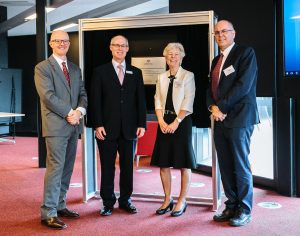Australia’s pulp and paper industries are set to be the beneficiaries of a new research hub that will look at transforming wood and other organic waste into everything from medicinal gels to food packaging.
On Friday 26 October, BioPRIA, Monash University launched the Australian Research Council (ARC) Hub for Processing Advance Lignocelluosics into Advance Materials – a game-changer for pulp and paper companies that will effectively become bio-refineries.
A total of $6.8 million over five years will be invested to convert materials, such as wood, plant-based matter and other biomass, into marketable chemicals and materials such as cellulose-based hydrogels for personal medicine (blood typing), nanocellulose films to replace plastic food packaging, and nanogels to help farmers maintain crops in the ever-changing climate.
An industry consortium of Australian Paper, Orora, Norske Skog, Visy, Circa and Leaf will join Monash, the University of Tasmania, the University of South Australia, the Government of Tasmania and AgroParis Tech as part of this ARC Hub.

Pictured L to R : Tim Woods, Director Industry Edge (Chair, BioPRIA Trustees Committee), Professor Gil Garnier, Director BioPRIA, Monash University, Prof Therese Jefferson, ARC Executive Director, Prof George Simon, Deputy Dean, Faculty of Engineering, Monash University
Professor Gil Garnier, Director of the Bioresource Processing Research Institute of Australia (BioPRIA), said this groundbreaking research will greatly help the Australian pulp, paper and forest industry transform their production waste into high-grade goods for the global marketplace.
“This Hub will leverage world-leading Australian and international research capabilities in chemistry, materials science and engineering with the express aim of creating new materials, companies and jobs for our growing bioeconomy,” Professor Garnier said.
“With ongoing support and vision from our government, industry and university partners, we will identify new applications and products derived from biowaste to transform the pharmaceutical, chemicals, plastics and food packaging industries in Australia and across the world.”
This industry transformation will be achieved through three specific objectives:
- Derive ‘green’ chemicals from Australian wood and lignocellulosic streams: Following examples in Europe and North America where high-grade chemicals, including gels and thermoplastics, are developed from wood extractives;
- Engineer new nanocellulose applications: Using Australian agricultural and wood residue to create nanocellulose and better nanofibers; and
- Develop ultralight paper and novel packaging: Creating cellulosic-based packing products with significantly improved physical properties and new attributes, including radio-frequency identification technology to integrate with transport / retail information systems.
“In fact, one of the goals is for our industry partners to generate, within four to 10 years, 25-50% of their profits from products that don’t exist today,” Professor Garnier said.
“This is an exciting time for Australia’s paper and pulp industry as we develop new products for existing markets and further grow our knowledge in bioresources. We’re pleased to be able to contribute to the nation-wide goal of reducing biowaste in our communities.”
